
How to Unlock iPhone 17 without Passcode
Is your Android phone locked due to a forgotten password or Google's security system? Here will tell you how to unlock Android device with Google Find Hub or Find My Device.

An essential condition for unlocking an Android with Google Find Hub is that you know the linked Google account credentials.
Over the years, the Android ecosystem has become inseparable from Google services, with Google Find My Device—now renamed Google Find Hub—being particularly relied upon by Android users. When your Android phone shows a message like "Locked by Find Hub" or "Locked by Find My Device," or if you are locked out because you forgot your Android device's password, you can unlock Android with Google Find My Device or Google Find Hub.
In this article, we will comprehensively introduce Google Find Hub and its features, guide you step-by-step through the process of using Google Find Device / Google Find Hub to unlock your Android device. Whether your phone is remotely locked or you've forgotten your password, this knowledge will help you move from a locked screen to regaining access to your digital world.
Tip: When Google Find Hub fails to help you unlock your Android phone, you can turn to Appgeeker Android Unlocker, a tool that removes your screen lock without any prerequisites, allowing you to get into your locked Android device without a password/PIN/pattern.
Table of contents
Google Find Hub, formerly known as Google Find My Device, is designed to be the digital guardian of your smartphone—a built-in, centralized security system that helps you remotely locate, lock, or erase data on your Android if it's lost or stolen.
As long as your Android devices, including phones, tablets, smartwatches, earbuds, and other accessories, are associated with your Google account, you can manage them through Google Find Hub, helping you recover a lost device or protect personal data in seconds.
The features of Google Find Hub
The utility of the Find Hub extends far beyond simple GPS tracking, offering five critical features that transform device security from reactive to proactive, some of which can even help you unlock the Android device:
To use Google Find Hub (or Find My Device) to unlock your Android phone or perform other tasks, certain specific conditions must be met.
1. The Android device must be powered on
Find Hub cannot connect to a powered-off device. The locked device must be turned on and have sufficient battery power to remain active.
2. Google account must be signed in
A linked Google account is at the core of the Find Hub system. Without an associated account, Google's servers will be unable to identify your Android device or communicate with it.
3. Internet connection is required
Find Hub operates through Google's servers, so a valid Wi-Fi or mobile data connection is crucial. Without a network connection, your remote commands to erase the device will not execute properly.
4. Find Hub feature must be enabled in Settings
Before the Android device is locked, location services and Find Hub/Find My Device (the former name of the core tracking feature) must have been turned on.
5. Visibility on Google Play
Your phone must also be visible on Google Play, which allows Google's network to identify and verify your device. You can check this at play.google.com/settings.
Facing a permanently inaccessible Android device because of a forgotten password, pattern, PIN leaves a user with exactly one Google's official recourse: reset your Android phone to factory settings. This process will clear the existing screen lock parameters and start over, allowing you to unlock your Android without a password.
But note that unlocking an Android phone via Google Find Hub means any data stored only on the device (i.e., not backed up to the cloud) will be permanently deleted. Users must be prepared for complete data erasure before proceeding.
Here's how to unlock your Android phone via Google Find Hub:
1. Prepare another device (PC or phone):
Open a browser and visit Find Hub or use the Find Hub app. Then, sign in with the Google account tied to the locked phone.
2. Identify the target device:
3. Initiate the reset operation:
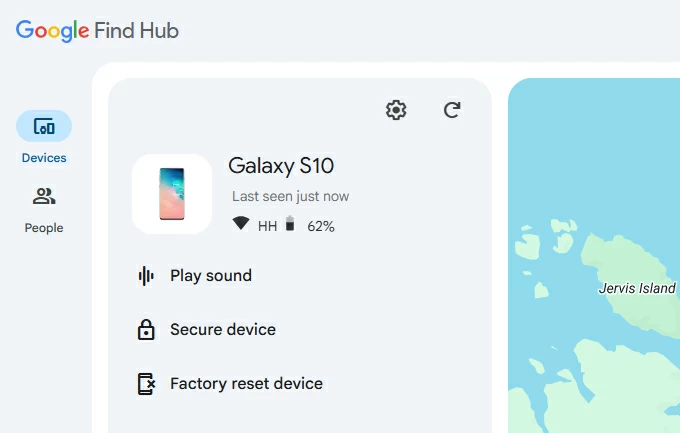
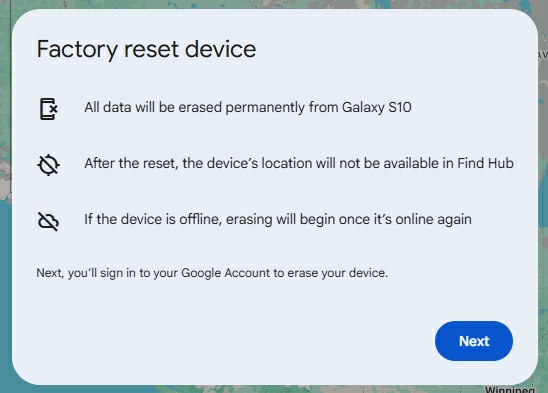
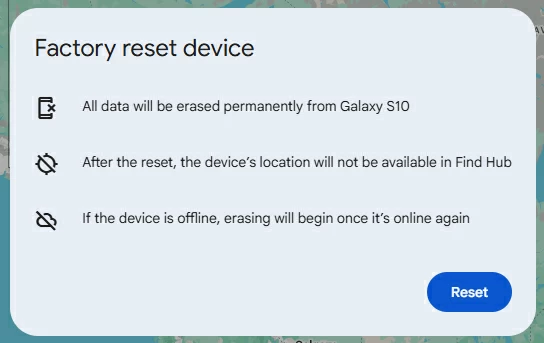
4. Wait for the wipe to complete:
5. Re-set and unlock the Android phone:
Post-reset security: Factory Reset Protection (FRP)
Resetting does not mean you've fully unlocked your Android device. To gain complete access, during the new setup process, a security protocol called Factory Reset Protection will be activated. This feature requires users to re-enter the username and password of the last Google account synced on the device to verify their identity. Only after successful Google Account verification will your device be truly unlocked.
Using your Google account through Google Find Hub to unlock the Android phone is indeed a feasible solution. But what if you forget your Google Account credentials? Or what if you fail to meet the necessary conditions for Find Hub to work?
In that case, you can easily bypass your screen lock and regain access via the professional Appgeeker Android Unlocker, requiring no additional preconditions or technical expertise. This software not only lets you unlock an Android device without entering a password/pattern/PIN, but also removes the FRP lock without verifying Google account details.
It supports most Android brands, such as Samsung, Motorola, Google Pixel, OnePlus, Xiaomi, and more, and is compatible with various versions of the Android OS, including the latest ones.
1. Install and launch the Android Unlocker software on your computer, then select the Remove Screen Password function to get your Android phone unlocked without a password.

2. Select the manufacturer of your Android device and connect it to your computer using a compatible USB data cable.
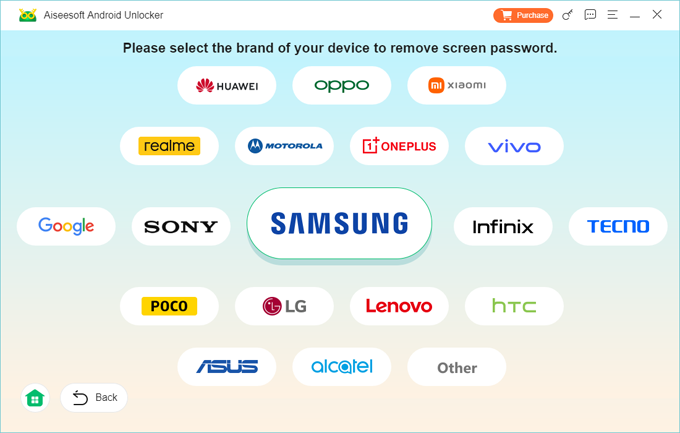
3. If the connection fails or the device is not recognized, click the The device is connected but not recognized link to view alternative connection solutions.
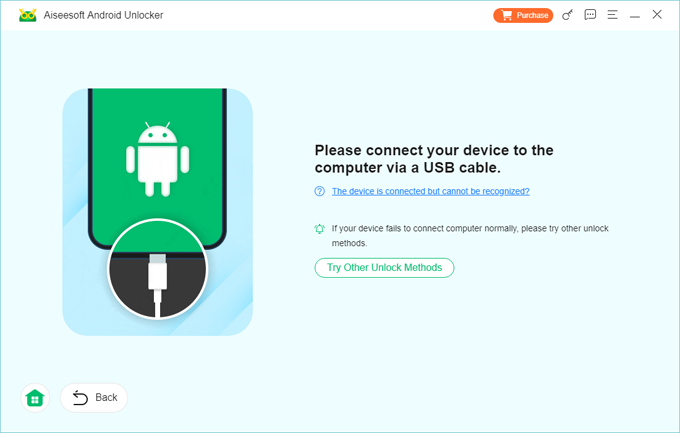
4. Once connected, click Remove Now to wipe your Android device to its default, lock-free settings.

When you see the "Remove successfully" message, your Android phone will boot to the initial setup screen. Follow the prompts to set up your device from scratch and complete the unlocking process.
A persistent message stating something like "Locked by Find My Device" or "Locked by Find Hub" presents a slightly different scenario than simply forgetting your password. This lock screen is the direct result of the device owner having proactively used the Google's "Secure device" remote feature to protect a phone they believed to be lost or stolen.
The Android phone is locked using a remotely set temporary password and often displays the owner's recovery contact information.

If you are the rightful owner who activated the Secure device function, the resolution is straightforward — enter the remote code.
The device will prompt you for a password/PIN. This is not the original forgotten password, but rather the new, temporary password or PIN that you set when you initiated the "Secure device" command via the Find Hub portal. If the code is correct, the phone will unlock, and you can reset your preferred screen lock.
A much more complex situation arises when this lock state is encountered on a device that was purchased secondhand or received as a gift.
If the previous owner fails to properly remove their Google account from the Android before performing a factory reset, it will trigger the FRP lock, thereby binding the device to the original owner's identity.
In such cases, the legitimate option is to contact the original owner and request the linked Google account information to complete the FRP verification step, or ask the original owner to remotely remove the device from their Find Hub device list, disassociating the device from their Google account.
Alternatively, you can use Appgeeker Android Unlocker to remove Google verification from your Android phone.
Conclusion
In summary, you now know what Google Find Hub is and its functions, and the situations where you need to unlock an Android device with Google Find Hub are generally divided into two types.
Remember to firmly memorize your Google Account credentials, as they are the key to utilizing Google Find Hub or Google Find My Device to unlock your Android device.
1. How do I turn off Google Find My Device or Find Hub completely?
You can disable it by going to Settings > Security or Security & Location, then locate the Find Hub or Find My Device and switching the toggle off. Alternatively, you can remove the associated Google account from your Android device. Keep in mind that this also removes the ability to track or erase the device remotely if it's lost.
2. Can I unlock my Android using Find Hub if I forgot my screen password?
Yes, but not directly. Find Hub can't bypass your existing screen lock, but you can erase the device remotely to remove the password altogether. This action performs a factory reset, allowing you to restore access—though it deletes all local data. Afterward, you'll need to sign in with your Google account during setup to pass the FRP.
3. What's the difference between Google Find Hub and the old Find My Device?
Google Find Hub is essentially the rebranded and upgraded version of Find My Device. It combines the familiar device-tracking feature with a broader ecosystem of connected accessories—like earbuds, tablets, and watches. The interface is cleaner, and its functions, such as "Secure device," "Play sound," and "Factory reset device," remain core but are better integrated across Google's ecosystem.